A. J. Stevens & Company
(1914) Limited - The later years.
| Racing success began early in 1928 when Len Cohen won the
South African junior T.T. over a distance of 240 miles, at
an average speed of 64.5m.p.h. He finished a full 17 minutes
ahead of the field on his 349c.c. A.J.S. machine. In March, George Rowley, and Charlie Hough gained first
class awards in the A.C.U. Standard Stock Trial along with
Frank and Adelaide Giles who won the combination award.
A.J.S. also received the team prize. Frank and Adelaide
Giles also won the ‘Olai’ cup for the best performance of
any passenger machine in the Victory Trial. A.J.S. also won
3 gold medals and 3 silver medals for the performance of
solo machines in the same trial. Gold medals were won by
Frank Giles, W. Brandish junior, and George Rowley, and
silver medals were won by S. Jackson, D. Brandish, and Jimmy
Simpson. The company also won 3 gold and 3 silver medals in
the Colmore Cup Trial.
|
|
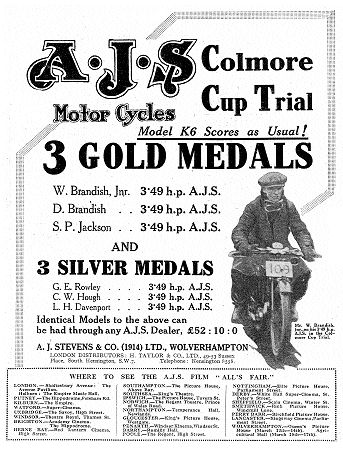
From 'The Motor Cycle', 8th March, 1928.
|
The A.J.S. team also had a wonderful performance in the
Scottish Six Days Trial. Leo Davenport won the silver cup,
Clarrie Wise won a gold medal, and silver medals were won by
Len Cohen, Frank Giles, and A. F. Downie. In Europe Tommy
Spann won the Dutch T.T., George Rowley won the
Czechoslovakian Grand Prix, and Wal Handley won the 350c.c.
German T.T. As in previous years there were many more
successful events. Six A.J.S. machines were entered for the 1928 junior Isle
of Man T.T. The riders were George Rowley, R. F. Parkinson,
Len Cohen, J. E. Wade, Tommy Spann, and Jimmy Simpson.
Unfortunately not one of them finished the course, they all
suffered with engine problems. Because of last year’s engine
problems, the new machines were fitted with the old type of
push rod engine. A new type of valve spring was used from a
new manufacturer. Unfortunately they failed, putting all of
the machines out of action. The valve springs were quickly
changed for the usual reliable type in readiness for the
senior race. The entrants were Len Cohen, Jimmy Simpson,
George Rowley, and Tommy Spann. Len Cohen and Jimmy Simpson
failed to finish, but George Rowley managed to finish in 2nd
place, just behind the winner, Charlie Dodson on his
Sunbeam. Tommy Span finished in 13th place.
|
| |
|
Read about
Clarrie Wise |
 |
| |
|
| This was another bad year for the company as UK sales
continued to fall. The company finally abandoned the
manufacture of radio receivers at Stewart Street. Previously
they had sold very well, but had recently been hampered by
extra competition and the seasonal nature of sales. The
Stewart Street factory was put up for sale, and purchased by
the Symphony Gramophone and Radio Company Limited for
£15,375. The new company not only purchased the buildings,
but also the contents, including the machinery and radio
components. About 100 people were employed in the works,
many of them being ex-A.J.S. employees.
Luckily overseas motorcycle sales actually increased, due
to the efforts of George Stevens.
Around this time Charles Hayward moved
to London to exploit his idea of financing new inventions
and processes. He formed the successful Electric & General
Industrial Trusts Limited, which led to the formation of the
Firth Cleveland Group of Companies. His position in the
company was taken over by Joe Stevens junior.
|

From 'The Motor Cycle', 29th March, 1928.
|
|
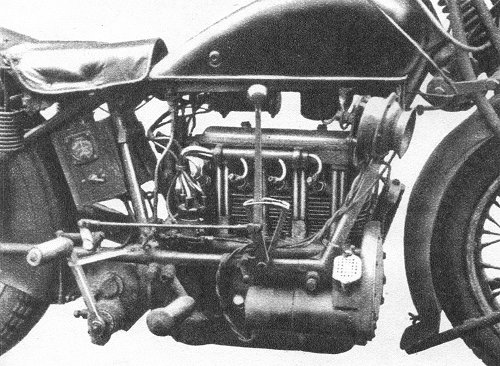
The 660c.c. in-line 4 cylinder
motorcycle. From 'The Motor Cycle'. |
An unusual prototype motorcycle was produced around this
time. It had a 660c.c. in-line 4 cylinder, air cooled,
overhead valve engine with a 3-bearing camshaft, driven by a
chain from the front end of the crankshaft. It had a
detachable cast iron cylinder head, and a built-in gearbox. The oil from the sump was pressure-fed to the rocker box via
an external radiator with four tubes. The machine was first
registered by George Stevens. Although the design showed
some promise it was not pursued. |
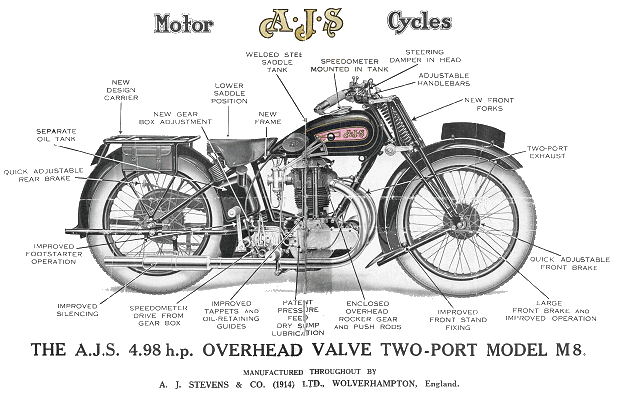
|
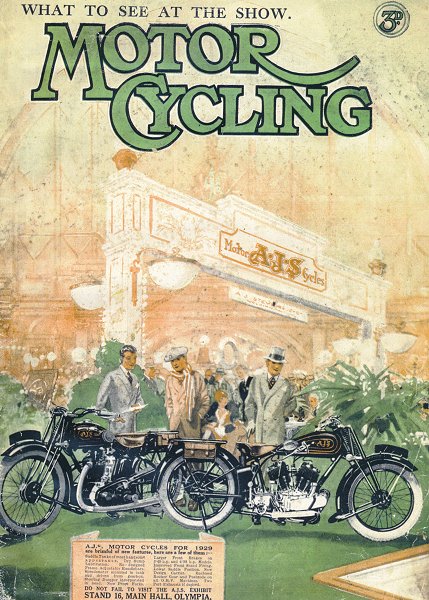
October 31st, 1928. |
The machines for 1929 were restyled to make them look
more up-to-date. The changes included a new style of petrol
tank, curved with magenta side panels. The ‘M’ range
included 14 models with 13 sidecar options. The machines
were given improved weather protection and featured cleaner
and quieter engines with dry sump lubrication.
New frames
were used to accommodate the new style of petrol tank, and a
new type of spring forks was introduced. Many of the
machines had a flush mounted speedometer on top of the
petrol tank.
The 'M1' and 'M2', the de luxe and standard 996c.c. sold
for £76.10s.0d. and £66 respectively. The 'M3', the de-luxe
tourer had a 349c.c. side valve engine, as did the 'M4', the
de luxe sporting version. Both machines sold for £48.10s.0d.
The standard sporting model, the 'M5' was priced at £45.
The 'M6' had an overhead valve engine, fitted with either a
single or twin port cylinder head. The single port version
sold for £52 and the twin port version sold for £54.10s.0d.
|
| There were two machines with an overhead cam, the 349c.c.
'M7' and the 498c.c. 'M10'. The 'M7' was available with wide
or close gear ratios and sold for £62, whereas the 'M10'
sold for £72. The 'M8' 498c.c. overhead valve machine could
be purchased with a single or twin port cylinder head. The
single port version sold for £59.10s.0d. and the twin port
version sold for £62.
The 'M9', a 500c.c. side valve de luxe
tourer, sold for £54, and the 'M12', a 248c.c. lightweight
machine, weighing only 193lbs, sold for £39.17s.6d.
Versions of the ‘M6’, the ‘M7’ and the ‘M8’ were
available for the popular sport of dirt track racing.
|

A 349c.c. 'M7', on display at the
National Motorcycle Museum. |
|
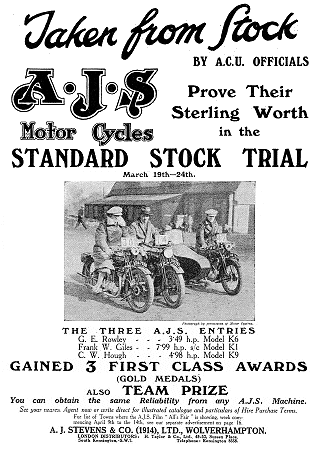
From 'The Motor Cycle', 5th April, 1928.
|
It had been another bad year for the
company with sales still falling and mounting financial
difficulties. Crucially, the contract with Clyno for the
production of car bodies came to a premature end in
February, 1929 when Clyno went into receivership.
This had
been essential to the future of production at Lower Walsall
Street because of the continuing decline in the sidecar
market. It ensured full-time working for the large number of
staff, and funded the project to develop A.J.S. commercial
vehicles.
This happened at the same time as the launch of
the first A.J.S. commercial vehicle chassis, the ‘Pilot’. To
try and offset this important loss, A.J.S. decided to
manufacture a light car, the A.J.S. ‘Nine’.
Although these were difficult times for the company, many
successes were gained in trials and competition events.
George Rowley, Clarrie Wise, and Leo Davenport all won first
class awards in the Scottish Six Days Trial in May, and the
manufacturers’ team prize for the best performance in their
class.
|
| Five riders were entered for the 1929 junior Isle of Man
T.T. They were A. W. Griffin, R. F. Parkinson, Frank
Longman, Wal Handley, and Tommy Spann. Wal Handley finished
in 2nd place, and Tommy Spann came in 15th.
The others failed to finish. There were four team entrants
for the senior race; George Rowley, Tommy Spann, Wal
Handley, and Frank Longman. The only one to complete the
course was Frank Longman who finished in 16th
place. In September Leo Davenport, and George Rowley came first
and second respectively in the 250c.c. class in the Ulster
Grand Prix. J. S. Anderson finished in 4th place riding
another A.J.S. machine.
The company made an attempt on the motorcycle land speed
record using a specially built 990c.c. machine, thought to
be capable of 150m.p.h. The project was championed by Jack
Stevens. The rider, Captain Oliver M. Baldwin had several
successful test runs at Brooklands before travelling to
Arpajon in France for the record attempt. The attempt ended
in failure when the engine seized after reaching a speed of
130m.p.h.
|
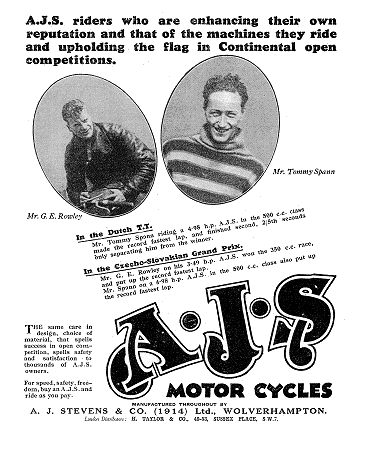
From 'The Motor Cycle', 12th July, 1928.
|
| In the autumn the ‘R’ series machines for 1930 were
prepared. The machines reverted to the original gold/black
colour scheme because the magenta side panels proved to be
unpopular. A chrome or nickel plated petrol tank was
available for an extra £1. |
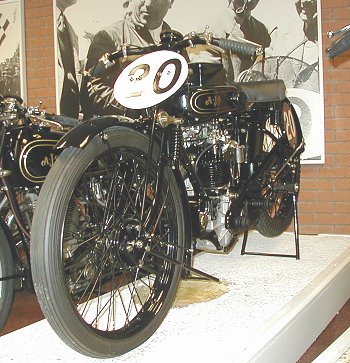 |
The 1930 A.J.S. 'R7' 350c.c.
works racer, on display at the National Motorcycle Museum,
Birmingham.
This model is one of the factory racers for 1930
and is known to have been ridden by Bert Denly.
It's just possible
that it might be the actual machine on which Denly and Baker broke
the 350c.c. three hour record at Montlhéry in October 1930 at
exactly 100mph.
Here, it is in Brooklands trim with the compulsory
'Brooklands Can' silencer which had to be used to pacify
local residents, who complained about noise. |
| There were fewer models in the new reduced-price range.
The top of the range side valve machine, the 996c.c. V twin,
'R2' sold for £63. There were three 349c.c. machines ranging
from the 'R4', the de-luxe side valve machine; the 'R5', the
standard lightweight machine; and the 'R6', the overhead
valve machine. Prices ranged from £44.10s to £53. There were two 498c.c. machines, the overhead valve, two
port 'R8' and the side valve 'R9'. The machines sold for
£59.10s.0d. and £52.10s.0d. respectively. The overhead cam
495c.c. ‘R10’ sold for £86, and the lightweight 248c.c.
overhead valve, 2 port machine, the 'R12' sold for £40.
By the end of the year sales were still falling, and for
the third year in a row the company failed to declare a
dividend to its shareholders. In 1930 a 10% reduction in pay
was made throughout the works in an attempt to reduce
running costs, and higher priority was given to the car
project.
As usual there were many successes in trials and sporting
events, but enthusiasm at the works must have been dampened
by the company’s serious financial position.
|
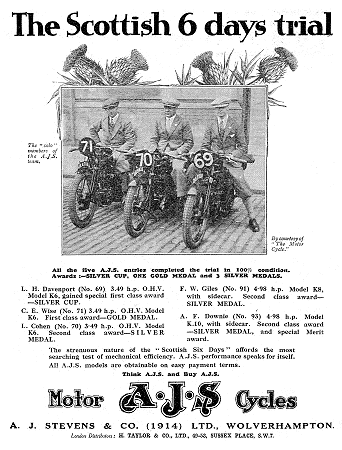
From 'The Motor Cycle', 19th July, 1928.
|
|
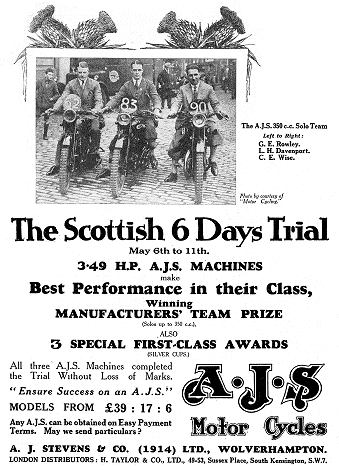
From 'Motor Cycling', 15th May, 1929. |
In April Tommy Spann married Millie Stevens at St.
Peter’s Church. Another good team was entered for the Isle of Man T.T.
Five team riders entered the junior event. They were Freddie
Hicks, Jimmie Guthrie, George Himing, Leo Davenport, and J.
G. Lind.
It was a disappointing race for A.J.S. George Himing finished in 8th place, Leo Davenport came
10th, and J. G. Lind came 11th. The
others did not finish.
In the senior race Freddie Hicks was
replaced by S. M. Williams, the other riders were the same.
Only J. G. Lind, and George Himing finished, in 9th
and 12th places respectively.
The team faired much better in the lightweight race. The
entries were Leo Davenport, Jimmie Guthrie, and J. G. Lind.
Jimmy Guthrie finished in first place at an average speed of
64.71m.p.h. J. G. Lind finished in 5th place, Leo
Davenport did not complete the course. |
| In August the long awaited A.J.S. ‘Nine’ car was finally
launched. Initially sales were good, helped by excellent
write-ups in the press.
It was hoped that car production
would keep the factory operating at full capacity. |
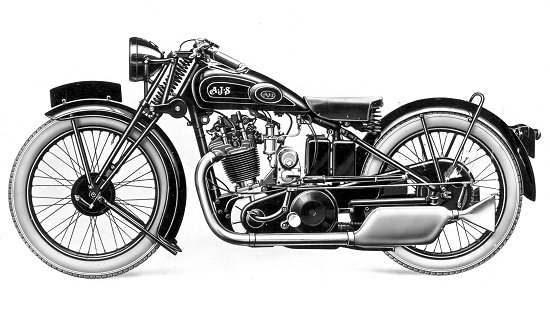
An A.J.S. 'R6'. Courtesy of the late Jim
Boulton. |
| There were three versions of the car. The 4-door fabric
bodied saloon sold for £230, the 4-door coachbuilt saloon
sold for £240, and the 2-door plus dickey coachbuilt open
tourer sold for £210.
Optimistically as ever, the company added 5 new models to
the existing range for the 1931 catalogue. The 'S' series
were extremely good value for money, and were offered at
very attractive prices.
The 'SA4', a smaller version of the
'S4' sold for £44. The 'SA5', a lightweight version of the
S5 side valve machine with 'Maglita' electric lighting, sold
for £40. The 'SB6', 'Big Port', single port 349c.c. overhead
valve machine, sold for £45. The 'SB8', 'Big Port', single
port 498c.c. overhead valve machine, sold for £49.17s.6d.
and the 'SA12', 248c.c. twin port, overhead valve machine,
sold for £40.
Although the new machines were well-priced,
sales remained low.
|
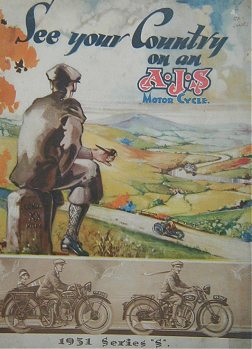
An advert for the 'S' series machines. |
|
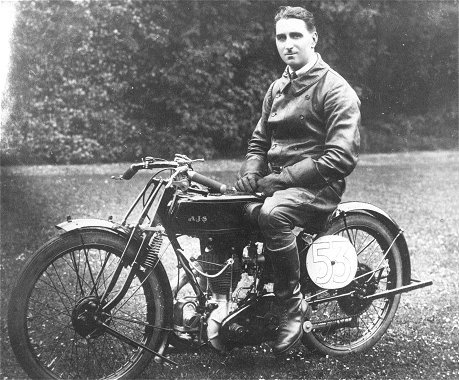
Clarrie Wise. Courtesy of the late Jim
Boulton. |
When the accounts were released they showed a loss of
£89,201. As a result share prices fell, and the company's
financial situation gradually worsened. The company took out
a loan with the Midland Bank in order to finance the
commercial vehicle and car business. The initial high hopes for the A.J.S. ‘Nine’ car were
dashed because sales sharply declined, mainly due to cheaper
competition. In February car prices were reduced by £11 and
the new cheaper fabric bodied ‘Richmond’ saloon was added to
the range. At the same time the A.J.S. ‘Admiral’ luxury
coach was launched.
|
| In April the ‘S3’ motorcycle made its first appearance.
It had a 498c.c. transverse V twin engine, an instrument
panel above the 3 gallon petrol tank, a top speed of
65m.p.h. and a petrol consumption of 60m.p.g. It sold for
£65. In spite of all the problems Freddie Hicks was entered
for the 1931 Isle of Man T.T. There were also five private
entrants, George Rowley, Tommy Spann, George Himing, D.
Brewster, and Tom Simister.
In the junior race Freddie Hicks did not finish, George
Rowley came in 9th, and George Himing came in 14th.
In the senior race none of the A.J.S. entries completed
the course.
Tragically Freddie Hicks was killed, after
loosing control of his machine and crashing into the doorway
of a small shop. A sad end to the company’s T.T. career.
|
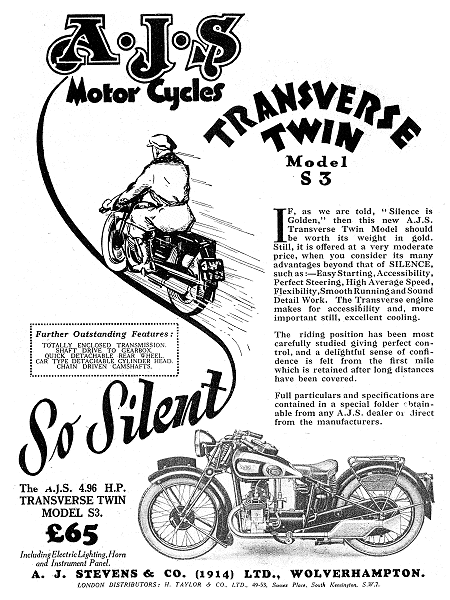
From 'The Motor Cycle', 9th July, 1931. |
| Some images from a
1931 A.J.S. catalogue: |
|
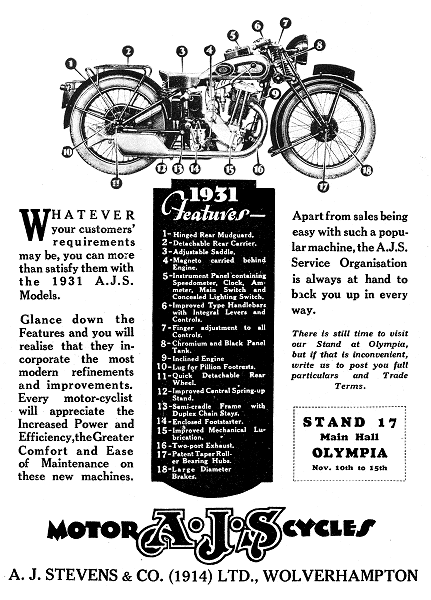
From 'The Motor Cycle and Cycle Trader',
14th November, 1930. |
Sales continued to decline and the Midland Bank became
unhappy about the company’s ability to repay their loan. The
bank decided to foreclose the loan, and although A.J.S.
managed to repay the outstanding amount, it was left with
only a small amount of working capital. An extraordinary general meeting of the shareholders was
called on 2nd October, at the Victoria Hotel.
A resolution
was passed for the company to go into voluntary liquidation.
John Todd Lewis of Agar, Bates, Neal & Company, of
Birmingham, was appointed as liquidator.
Prior to the meeting, the four brothers signed a
declaration of solvency with the Registrar of Companies on
22nd September, stating that in their opinion
they would be able to pay-off all creditors within 12 months
of winding up.
Matchless Motorcycles Limited of Plumstead, London,
purchased the A.J.S. name, manufacturing rights, and good
will for £20,000. BSA also put in a bid, which
being lower was not accepted.
|
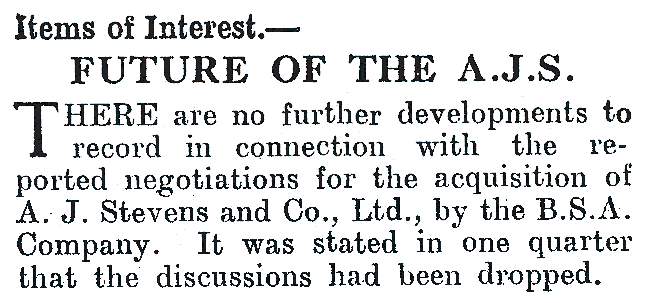
Before Matchless acquired A.J.S.., a
bid to buy the company was made by B.S.A. but this was
turned down. From 'Motor Cycle' 12th November, 1931.
|
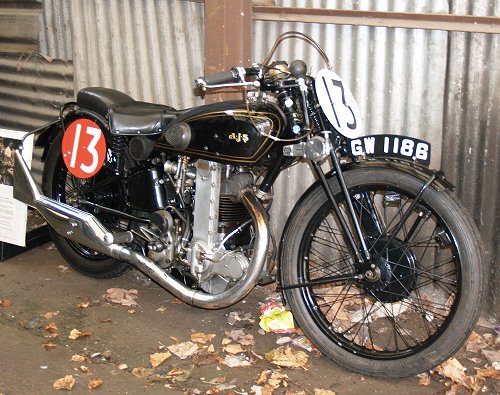
The 1931 works 'R10' that was
ridden by George Rowley in the 1931 senior T.T. The machine is owned by
Mike Botting. |
In January 1932 the A.J.S. 'Nine' car was sold to Willys-Overland
Crossley Limited of Heaton Chapel, Stockport for £9,500, and
re-launched in March as the 'New A.J.S. Nine', a re-styled,
coachbuilt 4 door saloon, costing £229.
The price was soon
reduced to £189 when it was realised that the car was in
direct competition with the Crossley 'Ten'.
The sidecar business, the 'Graiseley' name and the
remaining stock were sold to Diamond Motors of St. James
Square, Wolverhampton for £475. |
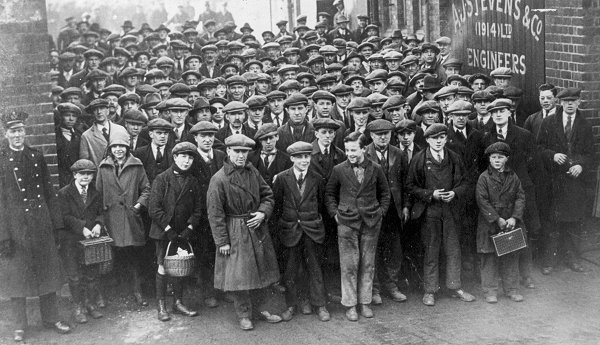
Workers leaving the main gates in 1931. Judging by
the children carrying lunch boxes, it must have been lunchtime.
Courtesy of the late Jim Boulton. |
| No buyer could be found for the commercial vehicle side
of the business and so the remaining parts were sold to
Charles Aaron Weight who ran the Briton Car Company. All of the creditors were paid in full by the end of
September 1932. The land and properties were eventually
sold. The Lower Walsall Street factory was sold on 25th
January, 1932 to the Ever Ready Company (Great Britain)
Limited, for £12,750. The Graiseley Hill site was split into
two, one half being purchased by the Star Aluminium Company
Limited, late in 1933, and the other half being purchased by
Wolverhampton Die Castings in February, 1934. The sale
raised £14,328.7s.6d.
A.J.S. also owned a piece of land on the corner of
Commercial Road and Lower Walsall Street that had been
purchased in 1925. It was sold towards the end of 1934 to W.
E. Jones, timber merchants and timber importers, for
£1,750.
It was a sad end for a company that had been so
important to Wolverhampton and the surrounding area. In the mid
1920's around 600 motorcycles were produced in a good week.
Due to the seasonal nature of the business there was a
certain amount of short time working, but the company still
produced around 20,000 to 25,000 machines a year.
The A.J.S. name was well known and respected throughout
much of the world. The workforce were well looked after by
the family, and both loyal and hard working. Many
engineers obtained their engineering skills while working
for the company, which in its heyday had a workforce of
between 3,000 and 4,000 people. The only reminder of the
once great company at Graiseley Hill is the memorial, erected by Safeway. It is aptly named 'The Lone Rider' and was
unveiled by Geoffrey Stevens on the 31st August, 1996. |
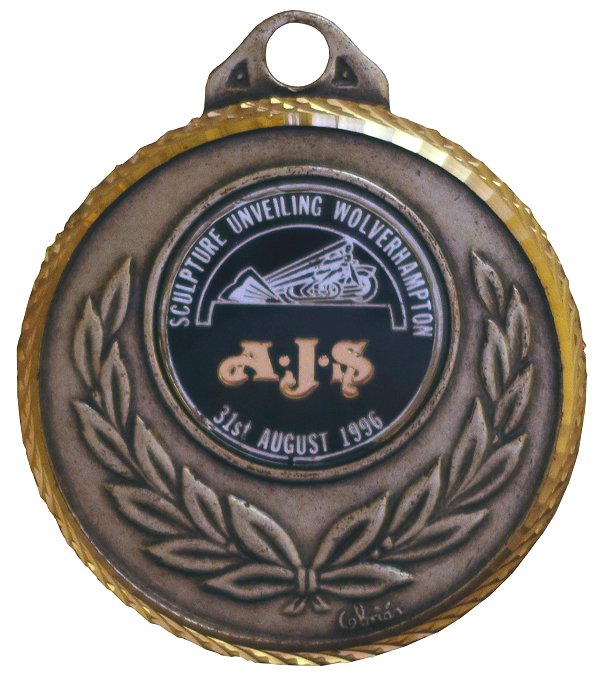
The medallion specially made for the event.
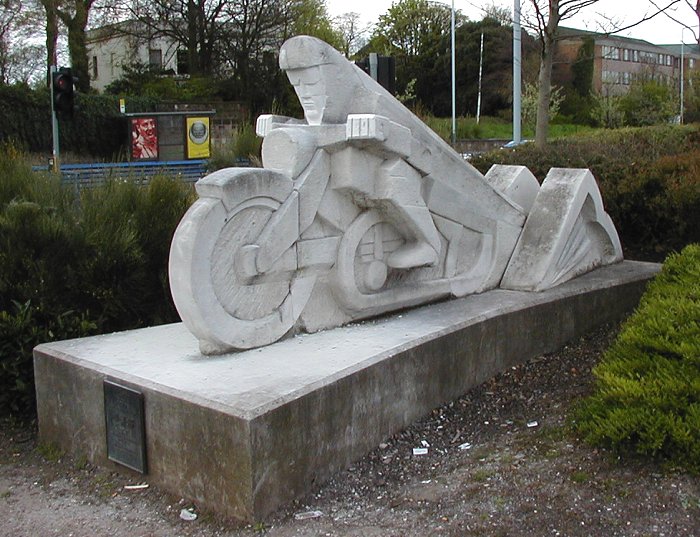
The 'Lone Rider' in 2002.
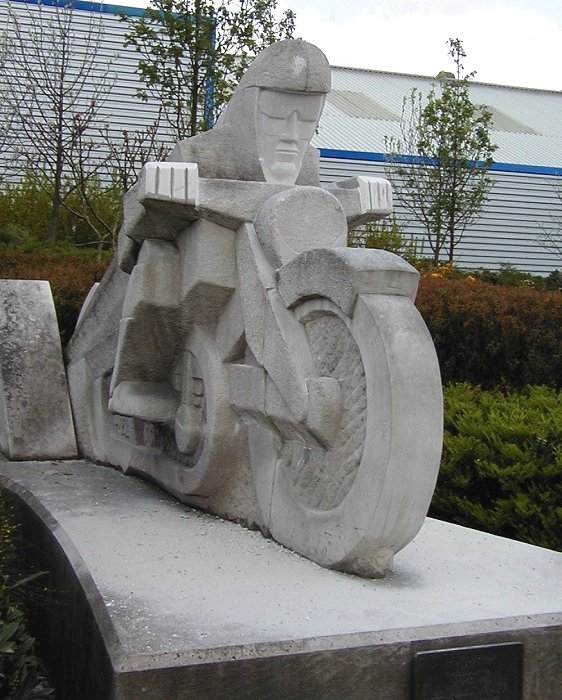
Another view of the 'Lone Rider'.

A close-up view, also from 2002.

In 2001 the statue was vandalised and
the face was badly damaged. The sculptor Rob Bowers saved
the day by carving a new face. He is seen here, hard at
work. |
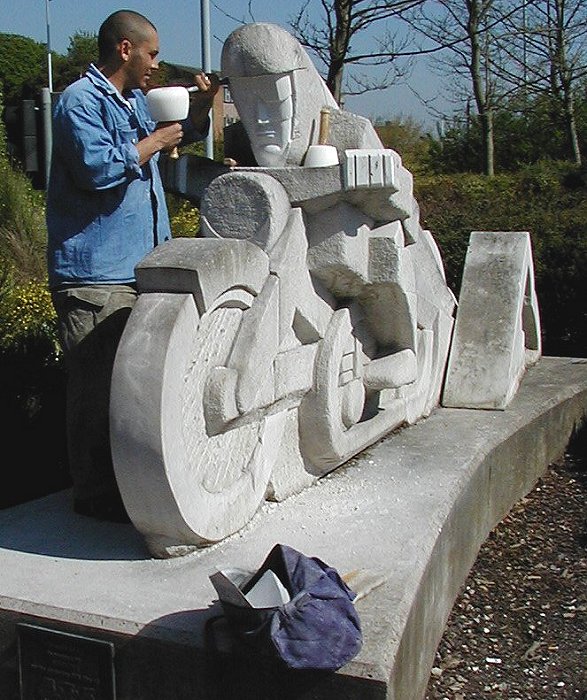
Another view of Rob Bowers and the statue.

Rob and the newly completed face.
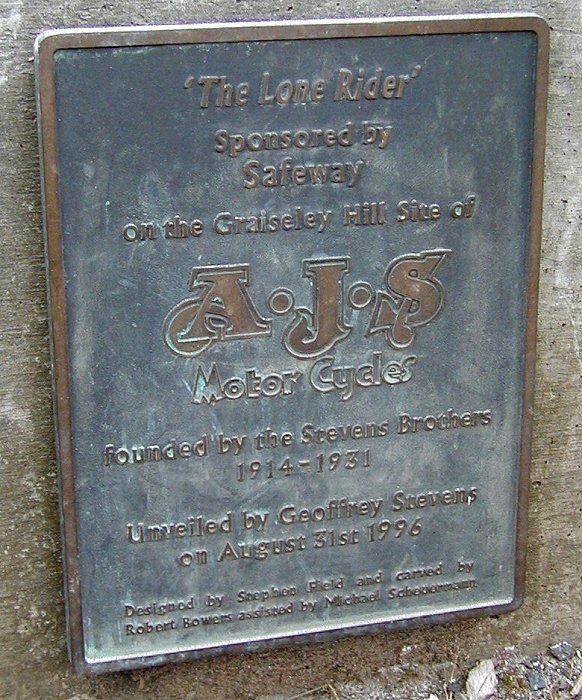
The bronze plaque on the front of the statue,
which sadly has been stolen.
 |
|
 |
Return to the
previous page |
|
Return to
the Beginning |
|